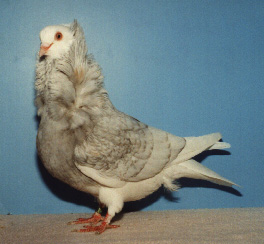 Dominant Opal
Dominant OpalIn the late 1970s I added the dominant opal gene to Old Dutch Capuchines. In the early 80s I spent 18 months in Germany doing church service during which time I was forced to give up my birds. Upon returning I was unable to locate any of my previous stock and the opals appeared to have vanished. In 1984 I repeated the cross of a flying roller with a red Capuchine and began the project anew. Opal Capuchines have done reasonable well in competition with a yellow opal winning champion at the first Lancaster National and an additional yellow opal being rating Highly Superior at the second Portland National. The bird pictured is a blue bar Dominant Opal bred by Cody Taylor of Castle Dale, Utah.
 Blue Bar
Blue Bar
Barred Capuchines have never been very popular and as a result, have lagged
behind other colors in quality. There has been a recent surge of interest in the barred
colors and the quality is beginning to rise. The blue bar pictured was
bred by Hans Hellmann of Ketsch, Germany. I photographed this bird during
my visit in December, 1995. American blues are not yet as good as the European
birds but progress is continual and the next few years should reveal some
very fine blues.
 Andalusian
Andalusian
Andalusian was added to Capuchines in the 1980s by Howard Bruensteiner
of Sebastopol, California. When Howard had to give up his pigeons in 1993
Frank Soto was the recipient of the andalusians. Frank shared the stock
with Jay Beals and the two of them have been the primary breeders of this
color. Currently there are a handful of breeders working
with andalusian and the quality is beginning to rise. The heads of
andalusian Capuchines are often "Komorner Tumbler-like" and this fault
has proven very difficult to eliminate. The bird pictured shows very
dark color with barely discernable lacing. A lighter color is preferred.
 Reduced
Reduced
The reduced gene is well named as it reduces the amount of pigment. In
a black pigeon, the color is "reduced" to a greyish coloration generally
with a darker lacing effect around the edge of each feather. The breast
is usually much lightened forming a silverish crescent. In some
expressions of reduced black the lacing is quite delicate with the bird
being a light silver with fine lacing in the wings. Other expressions
are more a charcoal grey with very little lacing. The reduced gene has
great variability but one of the key effects is the lightening of the
breast feathers. Other expressions of reduced which are attractive
are reduced blue t-pattern and reduced blue bar. The t-pattern is
a rusty ashy color with dark grey lacing. As a child I bred this
color in flying rollers where it was called "pink lace". The reduced
blue bar has a light pastel blue-grey ground color with rusty pink bars
with dark grey edging. A very attractive color and one which I hope to
breed again in the future.
Reduced is a sex-linked recessive factor and easy to introduce to a new
breed by using a reduced cock bird for the initial cross. All hens
from such mating will be reduced and can be used for further breeding.
These reduced hens mated back to cock birds of the desired breed will
produce sons which carry reduced and daughters which do not. Discard
the daughters and mate the sons to hens of the desired breed. These
pairs will produce mostly non-reduced offspring but will occasionally
breed a reduced youngster which will always be a hen. Then the process
is repeated indefinitely until the reduced birds are as good as the
desired breed. At this point a reduced hen can be mated to a cock bird
carrying reduced to produce the occasional reduced cock bird. When such
a cock bird is bred it can be mated to a reduced hen and produce only
reduced offspring. This is a fairly easy genetics project.Return by clicking on below
 Almond
Almond